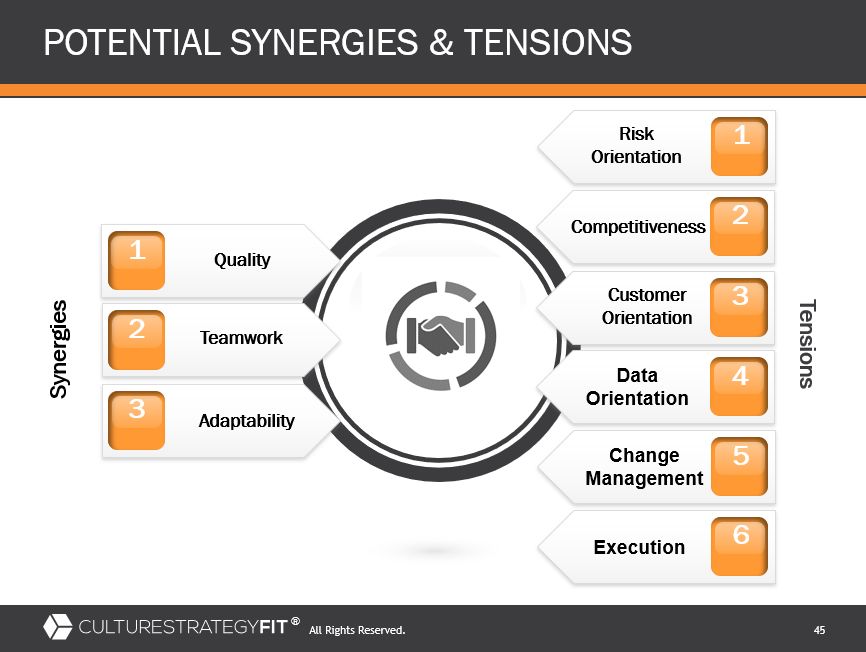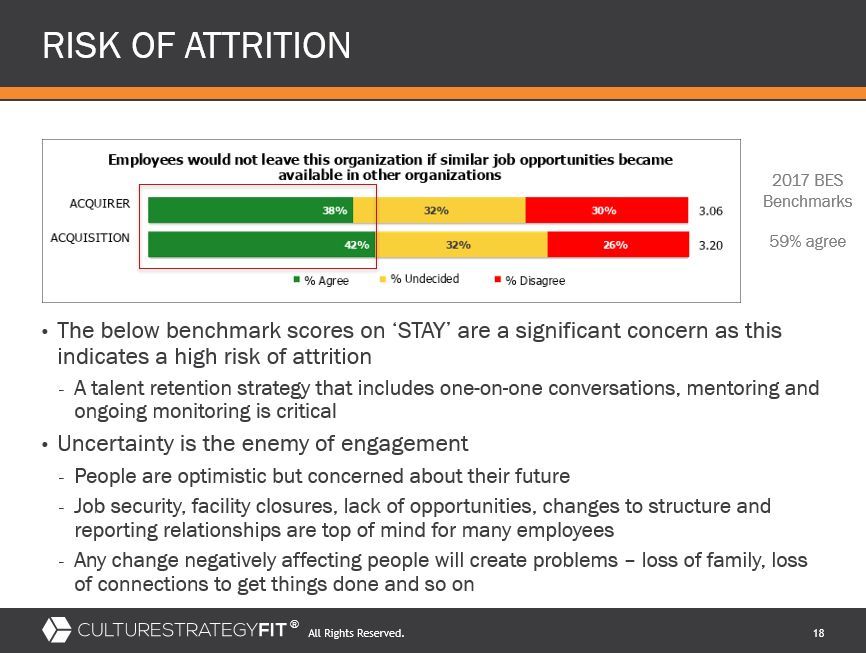The CULTURESTRATEGYFIT® M&A Culture Survey identifies potential sources of synergy and culture clash in merging organizations. This 75-item survey takes a close look at 23 high risk culture attributes plus the risk of attrition and resistance to change using 3 engagement drivers (Say, Stay, and Strive). A culture expert analyzes your survey results providing actionable insights that leaders, HR/OD professionals and or M&A teams can use to develop culturally appropriate and effective integration, communication, and change plans. This survey is suitable for internal mergers such as departments and business units, as well as acquisitions of external organizations.
WHAT IS INCLUDED?
We partner with you to run your survey and provide you with reports of your results. We analyze the results, prepare a report, and review the results with you. You receive:
- The M&A Culture Survey Report: A detailed report identifies cultural similarities and potential synergies, cultural differences and the potential for culture clash and provides a thematic analysis of the answers to the open-ended questions.
- Organization/Group Reports: A PPT report with the survey results for each organization or group (not analyzed).
- Report Debrief: One-hour webinar with a culture expert to discuss your survey results and the implications for integration.
OPTIONS
- Executive Summary (additional reports): Your survey results analyzed by a culture expert who prepares a summary of culture strengths and potential opportunity areas; includes a 1-hour webinar review of the survey results.
- Knowledge Transfer & Coaching: Workshops or hourly coaching is available.
For more information, download the
M&A Culture Survey Brochure here.
Additional Information
OVERVIEW
The M&A Culture Survey is a deeper dive than our M&A Culture Scan allowing for an in-depth analysis that provides the information leaders, integration teams, and HR/OD professionals need to focus their efforts on the areas most critical to integration success. We analyze your survey results and identify the implications of cultural differences for your integration efforts, as well as synergies that can be leveraged to help communication and change efforts go smoothly. This allows you to concentrate on the important stuff such as creating culturally appropriate and effective integration and change plans.
FAST FACTS
- Survey is completed by members of the acquiring and acquired organizations.
- Reports compare the results of similar demographics in the combining organizations.
- 75 items assess 23 potential areas of culture clash plus 3 engagement drivers.
- 2 or 3 open-ended questions add context and color to your data.
- 15-minute on-line confidential survey.
- User-friendly, rapid activation.
- Industry-leading data security.
- Accessible by desktop, phone, or tablet.
- Daily progress reports of survey participation.
- Available in English, Canadian French, and Latin American Spanish. Other languages can be added if required.
WHEN TO USE IT
The M&A Culture Survey can help you:
- Identify red flags: In some cases, cultural differences can present major risks that need to be addressed early in the integration process.
- Identify synergies and best practices: Uncover cultural practices that are sources of value to one or both organizations.
- Determine the best way to phase integration: One of the biggest risks of integration is to unknowingly damage the source of the acquisition’s value. For example, an acquisition that has built a tightly integrated customer-focused operation would suffer if an acquirer forced a change to its CRM or moved customer facing work to another office.
- Increase retention and engagement of critical people: With few exceptions, one of the keys to a successful acquisition is the ability to retain and engage leaders, experts, and others who have knowledge, customer relationships, and capabilities that are core to its value. While retention packages certainly help, this is not enough to ensure people will continue to dedicate the same level of energy and attention as they have in the past.
- Lower the cost of integration: The proactive identification and removal of obstacles caused by cultural differences allows integration activities to proceed more quickly and effectively thereby reducing associated costs.
HOW IT WORKS
Our Culture Resource Center partners with you to provide a quality survey experience for all parties. A simple Intake Form captures your requirements. Within 72 hours, your survey is setup and ready to go. Working together, we determine the best option for accessing the survey, complete a test and finalize details. For participants, completing the survey is convenient and user-friendly with confidentiality guaranteed. For data security, we employ industry-leading privacy and security measures. This results in better participation rates, increased candor and data accuracy, plus greater satisfaction with the survey process.



